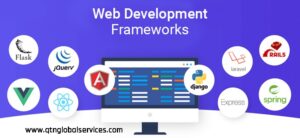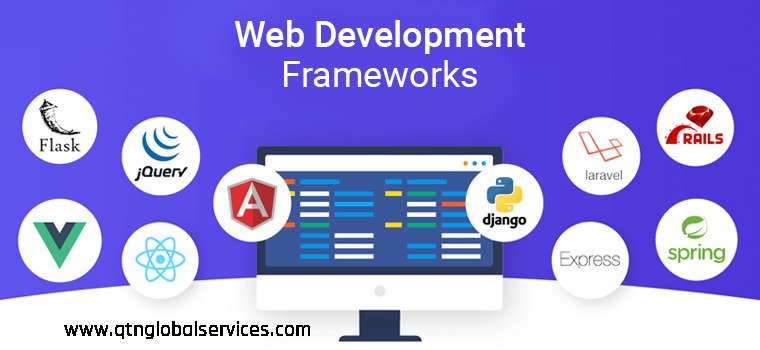In the ever-evolving landscape of web development, staying updated with the latest frameworks is essential for creating efficient, scalable, and visually appealing websites. Web development frameworks provide a structured foundation for building applications, streamlining the coding process, and enhancing overall development efficiency. In this article, we will explore some of the new and noteworthy web development frameworks that every developer should consider integrating into their toolkit.
Table of Contents
- Introduction to Web Development Frameworks
- The Benefits of Using Web Development Frameworks
- React.js: Building Interactive User Interfaces
- Angular: A Comprehensive Front-End Framework
- Vue.js: Balancing Simplicity and Flexibility
- Express.js: Creating Powerful Back-End Applications
- Ruby on Rails: Rapid Development and Convention over Configuration
- Flask: Lightweight Python Framework for Web Applications
- Laravel: Elegant PHP Framework for Modern Web Apps
- Django: High-Level Python Framework for Robust Applications
- Spring Boot: Java Framework for Microservices
- ASP.NET Core: Versatile Framework for Web and Cloud Applications
- Choosing the Right Framework for Your Project
- Getting Started with New Frameworks
- Embracing Continuous Learning in Web Development

Introduction to Web Development Frameworks
Web development frameworks are pre-built structures that provide developers with tools, libraries, and guidelines to simplify the process of creating web applications. They offer a standardized way of handling common tasks, such as routing, data management, and user interface design, allowing developers to focus on building unique features and functionalities.
The Benefits of Using Web Development Frameworks
Utilizing web development frameworks offers several advantages:
- Efficiency: Frameworks come with pre-designed components, reducing the need to write code from scratch and speeding up development.
- Consistency: Frameworks enforce coding standards and best practices, resulting in cleaner and more maintainable code.
- Scalability: Many frameworks are designed to support the growth of applications, making it easier to expand as user demands increase.
- Security: Frameworks often include security measures by default, protecting applications from common vulnerabilities.
- Community Support: Popular frameworks have active communities that provide resources, tutorials, and troubleshooting assistance.
React.js: Building Interactive User Interfaces
React.js is a widely used JavaScript library developed by Facebook. It specializes in creating dynamic and interactive user interfaces through a component-based architecture. Reacts virtual DOM (Document Object Model) efficiently updates only the necessary components when data changes, leading to improved performance.
Angular: A Comprehensive Front-End Framework
Angular, maintained by Google, is a robust front-end framework that provides a complete solution for building web applications. It offers features like two-way data binding, dependency injection, and a modular structure that simplifies development and testing.
Vue.js: Balancing Simplicity and Flexibility
Vue.js is a progressive JavaScript framework that strikes a balance between simplicity and flexibility. It can be integrated into existing projects or used to build new applications. Vue’s intuitive syntax and gradual learning curve make it a popular choice for developers of varying skill levels.
Express.js: Creating Powerful Back-End Applications
Express.js is a minimalistic and flexible Node.js framework designed for building back-end applications and APIs. It simplifies tasks like routing, middleware integration, and request handling, allowing developers to focus on core functionalities.

Ruby on Rails: Rapid Development and Convention over Configuration
Ruby on Rails, often referred to as Rails, is a popular web application framework that follows the principle of “convention over configuration.” It emphasizes developer productivity and follows best practices, enabling rapid development without sacrificing maintainability.
Flask: Lightweight Python Framework for Web Applications
Flask is a micro web framework for Python that is ideal for small to medium-sized projects. Its simplicity and modular design allow developers to choose the components they need, making it highly customizable.
Laravel: Elegant PHP Framework for Modern Web Apps
Laravel is a PHP framework known for its elegant syntax and modern features. It provides tools for routing, database migration, and user authentication, allowing developers to create sophisticated web applications efficiently.
Django: High-Level Python Framework for Robust Applications
Django is a high-level Python framework that prioritizes developer productivity and application security. It includes an ORM (Object-Relational Mapping) system, an admin interface, and built-in security features, making it a powerful choice for complex projects.
Spring Boot: Java Framework for Microservices
Spring Boot is a Java framework designed for creating microservices and stand-alone applications. It simplifies the configuration process and offers a range of tools for building production-ready applications.
ASP.NET Core: Versatile Framework for Web and Cloud Applications
ASP.NET Core is a cross-platform framework developed by Microsoft for building web and cloud applications. Its modular architecture, performance optimization, and compatibility with various platforms make it a versatile choice for different project requirements.
Choosing the Right Framework for Your Project
When selecting a framework, consider factors such as the project’s complexity, team expertise, scalability requirements, and desired technology stack. Evaluating these factors will help you choose the framework that aligns best with your project goals.
Getting Started with New Frameworks
To begin working with a new framework, explore its official documentation, tutorials, and community resources. Many frameworks offer step-by-step guides that cover installation, configuration, and building a basic application. Starting with small projects allows you to gradually gain proficiency and confidence.
Embracing Continuous Learning in Web Development
The field of web development is dynamic and ever-changing. New frameworks, libraries, and tools are constantly emerging. Embracing a mindset of continuous learning is crucial for staying up-to-date and ensuring that your skills remain relevant in this rapidly evolving industry.

Conclusion
In the fast-paced world of web development, staying abreast of the latest frameworks is essential for building innovative and high-quality applications. Each framework discussed in this article offers unique features and benefits, catering to various project requirements and developer preferences. By exploring and mastering these frameworks, developers can unlock their potential to create exceptional web experiences.
FAQs (Frequently Asked Questions)
- Can I use multiple frameworks in a single project? While it’s possible, it’s important to carefully consider compatibility and potential conflicts between frameworks before integrating them.
- Are newer frameworks always better than older ones? Not necessarily. Older frameworks might have a more mature ecosystem and better community support, while newer ones might offer more modern features.
- What if I’m new to programming? Which framework should I start with? For beginners, frameworks like Vue.js or Flask could be a good starting point due to their simplicity and beginner-friendly documentation.
- How can I keep up with the constant changes in the web development landscape? Engaging in online communities, following tech blogs, and attending web development conferences can help you stay updated on the latest trends and tools.
- Can I switch frameworks in the middle of a project? While possible, switching frameworks midway can be challenging and time-consuming. It’s best to choose the right framework at the project’s outset.





